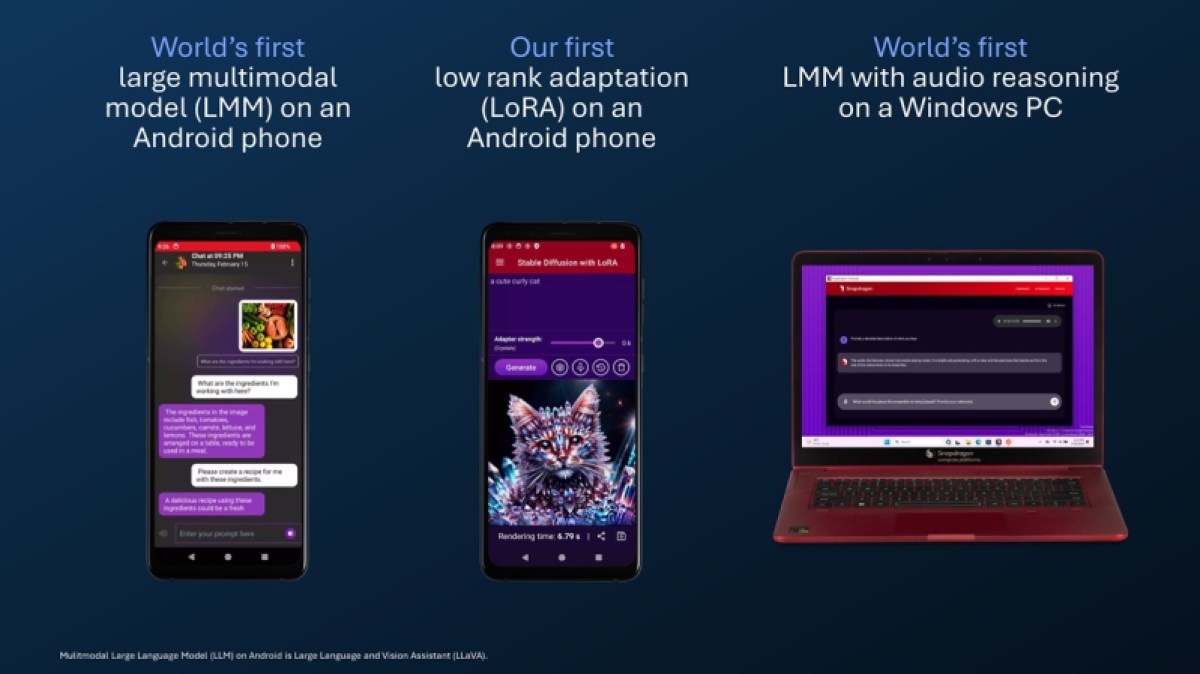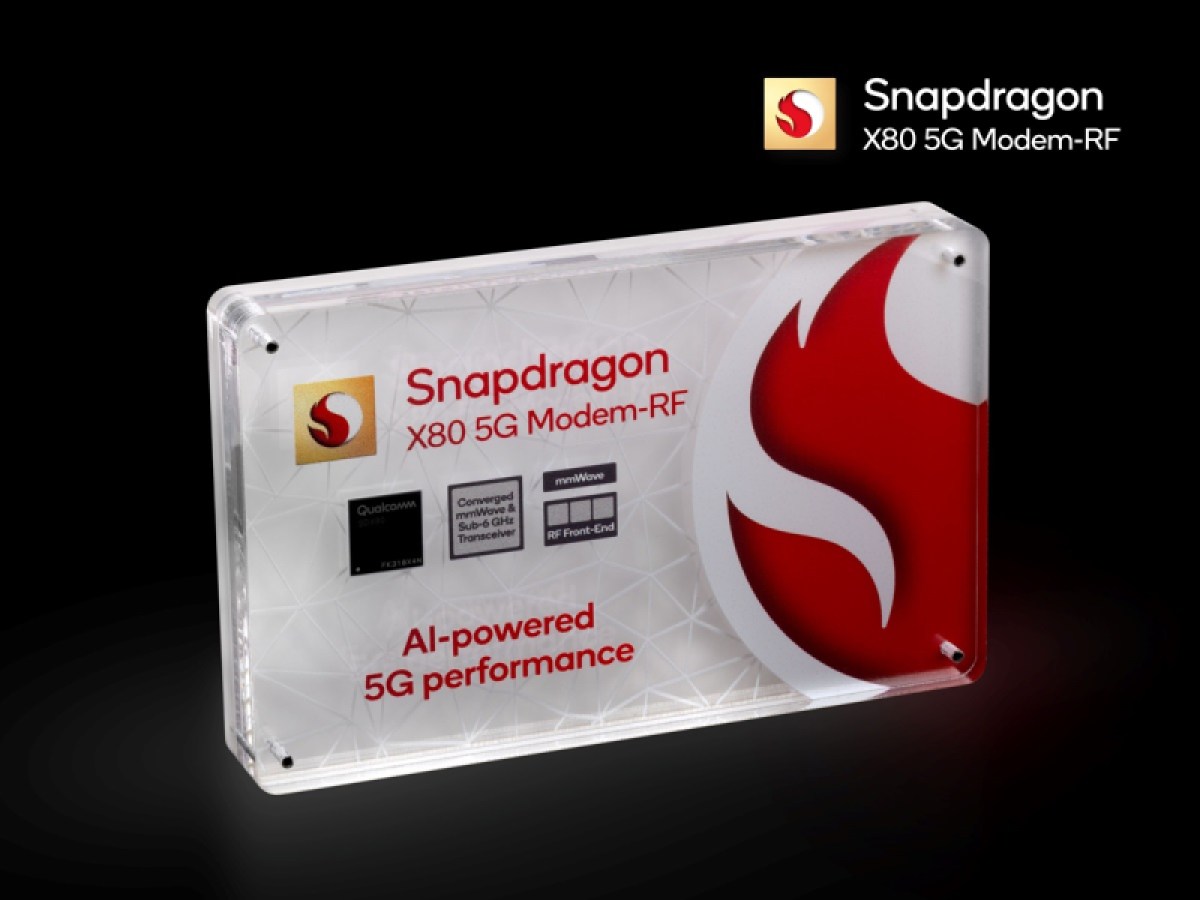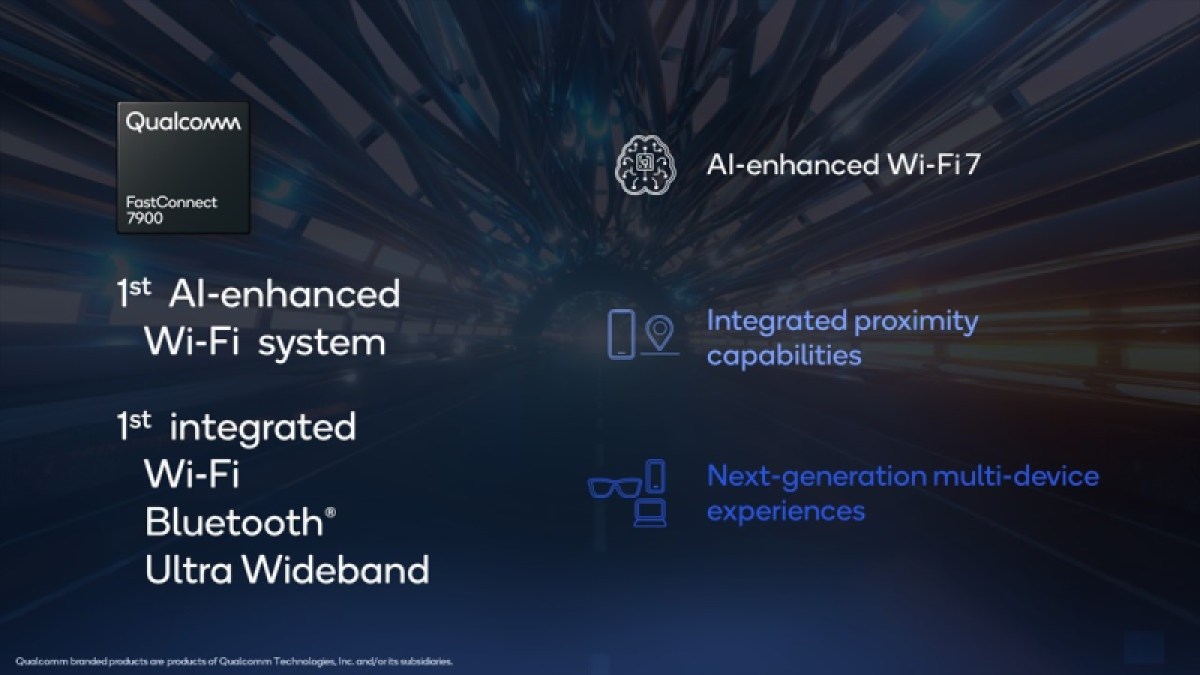Qualcomm unveiled a suite of AI, 5G, and Wi-Fi devices at Mobile World Congress (MWC) in Barcelona.
The chip design company said the innovations promise to usher in a new era of intelligent computing, transforming industries, devices, and consumer experiences.
For Qualcomm, the commercialization of on-device AI was sparked by the Snapdragon 8 Gen 3 and Snapdragon X Elite for business that were announced a couple of months ago and now the first round of devices are coming out. They’re coming from Samsung Galaxy, Xiaomi, OPPO and others in China. More are coming out at Mobile World Congress.
Cristiano Amon, CEO of Qualcomm, said in a statement, “The future of generative AI is hybrid, with on-device intelligence working together with the cloud to provide greater personalization, privacy, reliability, and efficiency. Connectivity is critical to help generative AI scale and extend across the cloud, edge, and device.”
GB Event
GamesBeat Summit Call for Speakers
We’re thrilled to open our call for speakers to our flagship event, GamesBeat Summit 2024 hosted in Los Angeles, where we will explore the theme of “Resilience and Adaption”.
Amon further highlighted Qualcomm’s commitment to enabling the ecosystem to develop and commercialize generative AI use cases, experiences, and leading products across various device categories, including smartphones, next-gen PCs, XR devices, vehicles, robotics, and more.
The key highlights of Qualcomm’s MWC announcements include:
Qualcomm AI Hub

Featuring a new library of over 75 pre-optimized AI models, the Qualcomm AI Hub is designed for seamless deployment on devices powered by Snapdragon and Qualcomm platforms. Developers can integrate these models into applications, reducing time-to-market and unlocking the benefits of on-device AI, including immediacy, reliability, privacy, personalization, and cost savings.
“When we talk about edge devices, we’ll talk about PCs, cars, phones, industrial IoT, Wi Fi access points, cellular infrastructure, and more,” said Ignacio Contreras, senior director of Qualcomm products and technologies marketing, in a press briefing. “And our job as a company is to empower all these devices with outstanding connectivity, AI, and energy efficient processing. So at the end, all these devices can serve users like you, and help us make progress, making lives more productive, more convenient, and more fun.”
The devices fall into the context of delivering intelligent computing everywhere.
As part of the MWC Barcelona showcase, Qualcomm will be demonstrating AI research, including the world’s first large multimodal model on an Android phone, Stable Diffusion with Low-Rank Adaptation, and on-device demonstrations of a seven-plus billion parameter large multimodal model running on a Windows PC.
Generative AI functions in upcoming smartphones, Windows PCs, cars, and wearables will also be on display with practical applications. Generative AI is expected to have a broad impact across industries, with estimates that it could add the equivalent of $2.6 trillion to $4.4 trillion in economic benefits annually.
Durga Malladi, senior vice president and general manager, technology planning and edge solutions at Qualcomm, said in a statement, “The Qualcomm AI Hub provides developers with a comprehensive AI model library to quickly and easily integrate pre-optimized AI models into their applications, leading to faster, more reliable and private user experiences.”
On-device AI

Contreras said that the commercialization of on-device AI is starting now.
“The benefits of on-device AI are clear in terms of the immediacy of the responses that we can get from large language models and generative AI applications for reliability because we don’t depend on servers that may do this at some point, or that might need a subscription to operate privately because everything remains in your own device,” Contreras said.
These devices have more personalization because Qualcomm can take advantage of the many sensors around the device to be able to provide more personalized responses and activities.
Contreras said that the devices will be able to leverage the NPU in the Qualcomm chipset or the GPU or CPU as needed. There will be AI assistants that can help boost the performance of 5G and Wi-Fi devices as well, he said. The AI can identify Wi-Fi usage for movie downloads or video conferencing and optimize the connection for those applications, where latency problems are important. If you are watching a movie, streaming and power efficiency is more important and buffers can be enlarged. In this case, the AI model runs on the Wi-Fi chipset itself, Contreras said.
“We are thrilled to host Qualcomm Technologies’ AI models on Hugging Face,” said Clement Delangue, CEO of Hugging Face, in a statement. “These popular AI models, optimized for on-device machine learning and ready to use on Snapdragon and Qualcomm platforms, will enable the next generation of mobile developers and edge AI applications, making AI more accessible and affordable for everyone.”
AI PCs on the way

AI PC models will be arriving within a few months.
On a Windows PC, Qualcomm AI Research is showcasing a world’s first on-device demonstration of a 7+ billion parameter LMM that can accept text and audio inputs (e.g., music, sound of traffic, etc.) and then generate multi-turn conversations about the audio.
And on smartphones, Qualcomm is displaying a range of flagship commercial AI smartphones powered by the Snapdragon 8 Gen 3 Mobile Platform, including the HONOR Magic6 Pro, OPPO X7 Ultra, and Xiaomi 14 Pro.
Each of these devices includes exciting new generative AI features, such as AI-generated image expansion (Xiaomi), AI-powered video creation and AI-powered calendar creation (HONOR), and image object eraser (OPPO).
On PCs, the new Snapdragon X Elite and its 45 TOPS NPU is built for on-device AI that
will transform how we interact with our PCs. Using the popular and free image editor
GIMP with the Stable Diffusion plug-in, Qualcomm will demonstrate that you can type an image you want and generative AI will create an image in 7 seconds—that’s three times faster than x86 competitors.
“Once we have on-device AI capable phones, PCs and others distributed into users’ hands, the next step is to enable developers to create new and exciting applications using these capabilities,” Contreras said. “So on the first day of Mobile World Congress, we’re introducing the Qualcomm AI Hub. The Qualcomm AI Hub is a central location for AI developers to access resources aimed at deploying AI applications on Snapdragon or Qualcomm platforms.”
One of the key enablers of this Qualcomm AI Hub is a library full of optimized models quantized and tested to perform very well on Snapdragon and Qualcomm platforms. The developer selects an efficient model for images for segmentation or face detection. Developers select different preferences like TensorFlow and the right Snapdragon platform and the device.
The developer will be guided to the right model based on these choices for optimized models to take advantage of on-device AI. There will be 75 AI models available for developers to choose from, with the result being performance that is up to four times faster for inferencing.
Contreras said Qualcomm will reveal the world’s first large language model and large multi-modal model running on an Android phone. This demonstration will show a 7 billion parameter large multi-modal model that can accept not just text, but also images and voice.
Snapdragon X80 5G Modem-RF System

Touted as the world’s most advanced 5G modem-to-antenna platform, the Snapdragon X80 architecture integrates 5G-Advanced capabilities. It is the first modem with fully integrated NB-NTN satellite communications support for connectivity to non-terrestrial networks.
In connectivity, the new Snapdragon X80 Modem-RF System integrates a second-generation 5G AI processor to enhance cellular performance, coverage, latency, and power efficiency.
The dedicated tensor accelerator powers AI optimization, improving throughput, quality of service, coverage, latency, spectrum efficiency, power efficiency, and mmWave beam management.
The new modem is a seventh-generation RF system for 5G, powered by AI.
With it, you can get speeds that are 20% better speeds at the edge of the cell very far from the antenna with lower battery consumption. Qualcomm is also introducing the first AI-based multi-antenna management system. The goal is to make sure 5G leaves no one behind. Qualcomm said it will enable gigabit 5G smartphones for less than $100.
Qualcomm FastConnect 7900

This mobile connectivity system is the first to deliver AI-optimized performance and integrates Wi-Fi 7, Bluetooth, and Ultra Wideband technologies in a single chip. Utilizing AI, FastConnect 7900 adapts to specific use cases and environments, optimizing power consumption, network latency, and throughput.
And with 5G Infrastructure, Qualcomm will showcase three AI-based enhancements for network management, including a generative AI assistant for radio access network (RAN) engineers to simplify network and slice management tasks, an AI-based open RAN application (rApp) that reduces network energy consumption, and an AI-based 5G network slice lifecycle management suite.
Contreras said, “The Fast Connect 7900 is the first AI enhanced Wi-Fi system. You see how connectivity will enable hybrid AI, but also AI will enable better connectivity. This is the first integrated Wi Fi, Bluetooth and ultra wideband system that will allow us to bring new proximity capabilities — not just data, but also proximity capabilities into a new generation of devices.”
“The important thing is that all of these capabilities, whether developers decide to use one or the other radio or technology packed within Fast Connect 7900, we are abstracting the use of the user application from the technology,” Contreras added. “And users can just find what they need, without having to worry about which technology to use.”
These chips use less space and are more cost effective. That leaves more space for the battery.
In automotive, Qualcomm said it is leveraging its AI hardware and software solutions, demonstrating traditional and generative AI capabilities with the Snapdragon Digital Chassis Platform, aiming to deliver more powerful, efficient, private, safer, and personalized experiences for drivers and passengers.
In consumer internet of things (IoT), Qualcomm is showcasing Humane’s AI Pin that runs on a Snapdragon platform and offers users the ability to take AI with them everywhere in an entirely new, conversational, and screenless form factor.
VentureBeat’s mission is to be a digital town square for technical decision-makers to gain knowledge about transformative enterprise technology and transact. Discover our Briefings.

